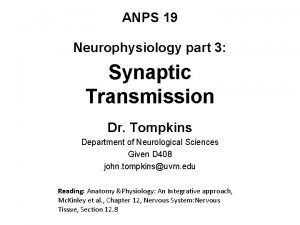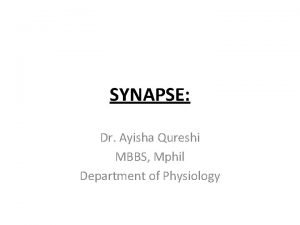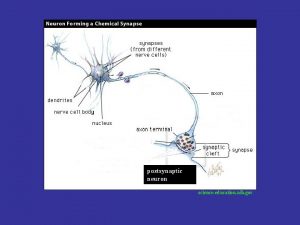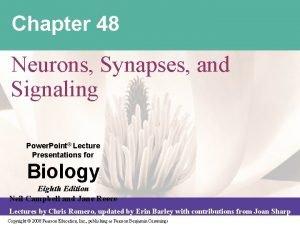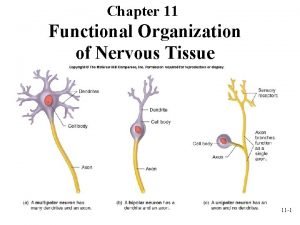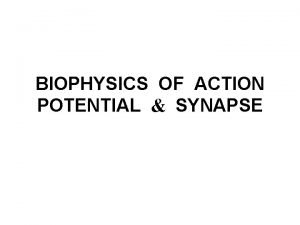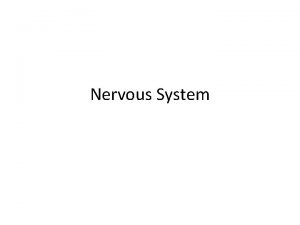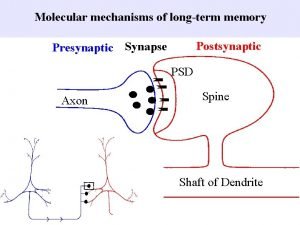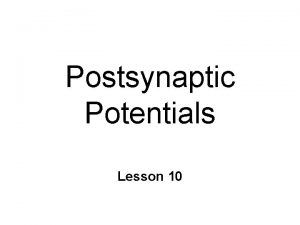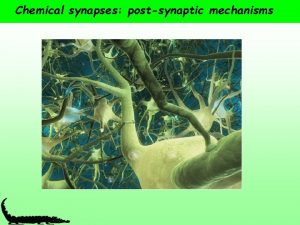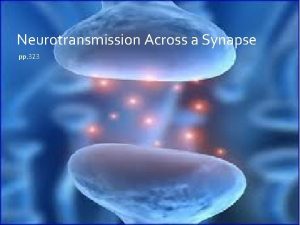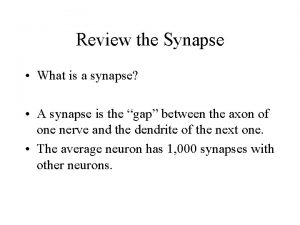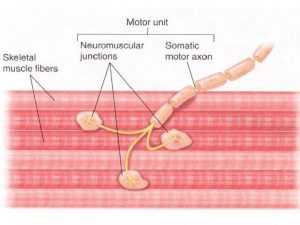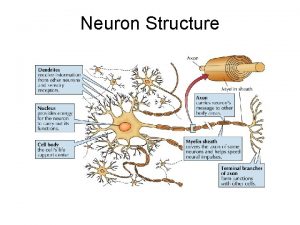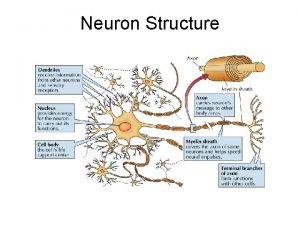Synapse formation 2 Effect of postsynaptic cell on










- Slides: 10

Synapse formation (2) Effect of postsynaptic cell on presynaptic differentiation – Retrograde signals involved in active zone formation – Synapse elimination

Retrograde signaling for presynaptic differentiation • Contact with postsynaptic target induces active zone (localization of Ca channels and synaptic vesicles) • After axotomy, regenerated axon form NMJ at pre-existing sites of the muscle fibers. Active zones form near the junctional folds • These observations suggest existence of retrograde signals, but the nature of these signals is not well understood • Some of these signals appear to reside in basal lamina, because even if muscle fiber is damaged, the motor neuron innervates the empty basal lamina sheaths and form active zones at the pre-existing locations. Active zones NMJ occupies 0. 1% of muscle fiber surface

Laminin (a component of basal lamina) is important for active zone formation Normal Laminin b 2 knockout The effect of laminin may be mediated by its interaction with presynaptic Ca 2+ channels

Interaction with muscle fibers determine synapse stabilization or elimination For skeletal muscles - Each embryonic muscle fiber is innervated by multiple motor neurons - Each adult muscle fiber is innervated by a single motor neuron

Gan & Lichtman, Science 282 (1998) Axons at multiply innervated neuromuscular junctions gradually segregate as development proceeds. (A) Two intermingled competing nerve terminals at this P 1 junction labeled with Di. O (green) and Di. I (red). Small white circles indicate centroids of each labeled axon (8). (B) A multiply innervated junction at P 4 shows less intermixing than seen at birth. Arrows (red and green correspond to Di. I- and Di. O-labeled branches, respectively) show thin branches of each axon in the territory that is dominated by the other axon. (C) A multiply innervated junction at P 10 in which the two inputs are separated by an uninnervated gap (at most junctions at this age, however, the inputs are separate but juxtaposed). (D) At P 17, two competing axons at this rare remaining multiply innervated junction show a large separation between two inputs. In this case, both axons were stained with an antibody to neurofilament (green) and the postsynaptic ACh. Rs were labeled with fluorescently tagged -bungarotoxin (red). (E) The segregation index (8) increases through early postnatal life. Each circle represents an individual junction; horizontal bars are the means of the segregation index. Scale bar in (D), 10 µm [shows scale for (A) through (D)].

Synapse elimination: activity-dependent competition Competition - If you remove some of the motor neurons early in development, at the end all muscle fibers are still innervated, indicating that synapse elimination is not pre-determined - After achieving single innervation, removal of the original motor neuron causes other motor neurons to take over the muscle fiber Activity-dependent • • TTX (blocks Na channels, action potentials) blocks elimination (the same muscle fiber remain innervated by multiple motor neurons) a-bungarotoxin (a snake toxin that blocks ACh. R) blocks elimination Thus this synapse elimination process requires presynaptic motor neuron action potential that triggers synaptic tranmission and activation of ACh receptors. More active synapse tends to win the competition!

(1) Synaptotrophins: maintenance factors released by muscle fibers (e. g. , BDNF, CNTF, …? ? ? ) (2) Synaptotoxins: factors that damage the nerve terminal (e. g. , proteases) (3) Synaptomedins: factors that are precisely localized at the synaptic site (ACh. Rs, rapsyn, etc). (3) seems to be the best model in vivo.

Synapse elimination can occur at the level of single terminals ACh receptor lost precedes withdraw of nerve terminal

Development of central synapses are similar to development of NMJ • • • Receptor clustering at central synapses is also likely mediated by agrin, neuregulin, and activity Each central neuron receives multiple types of synaptic inputs (e. g. , glutamatergic, GABAergic), thus likely to require multiple clustering signals Central synapses do not have basal lamina, adhesion may be mediated by pre- and postsynaptic transmembrane proteins (e. g. , neurexin, neuroligin)

Nature vs. Nurture • Initial wiring is genetically controlled • But environmental (e. g. , sensory) input is critical in early development – Occular dominance columns
